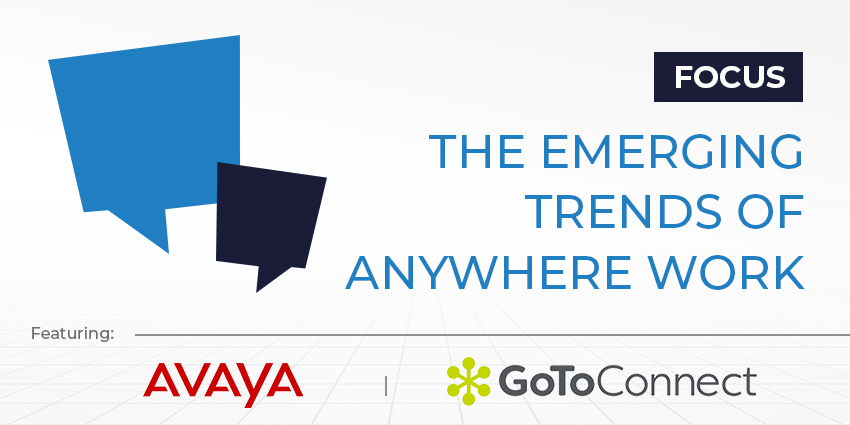Technology has been implementing features that enable ‘work form anywhere’ for a few years now, but the onset of the pandemic meant that those capabilities were no longer a nice-to-have but an absolute necessity.
We spoke with Neal McMahon, Regional Sales Leader UK&I at Avaya and Sion Lewis, VP and MD EMEA at LogMeIn to gather their insights on how working from anywhere has developed recently and how they expect it to evolve next year.
How has the trend of anywhere work developed over 2021, particularly as parts of the world have opened up?
Avaya’s Neal McMahon stated that the digital workplace has now arrived, and collaboration has advanced to where employees are empowered to meet unplanned work head-on.
“By fusing employee experience with customer experience through the new, always-on, online front door, organisations support the fluid nature of problem-solving to drive experiences across the enterprise that are successful and fulfilling for everyone, meeting the challenges of a work-from-anywhere world with multi experience collaboration that crosses devices, touchpoints, and modalities,” he said.
The compulsory shift to remote working as a result of the Covid-19 pandemic has also widened the pool of talent that organisations can tap into, as well as allowing employees to determine their own working conditions and locations, said LogMeIn’s Sion Lewis, who further warned that these companies must “embrace” the will of workers as the pandemic is still very much with us.
“Employees must feel empowered to ask for working arrangements that not only make them the most productive employee but also take into consideration a work-life balance,” he advised.
“We need to change our style to create a people-first culture – ensuring team members are connected and have strong workplace networks that are above all else equal regardless of their location. Shifting to an ‘anywhere’ work programme is not a simple task, but it is critical for business success. It may have taken a pandemic to bring this to light, but it is an outcome we can embrace”
How has this changed the demands of the technology that people use to work – particularly out of the office?
The need for remote access and support solutions that offered more security while ensuring user productivity has increased dramatically over the pandemic, said Lewis, adding that collaboration technologies have also been “fundamental” in allowing teams to work closely together.
“Imagine not having a digital human connection when working remotely?” he pondered.
These tools can do more than help teams get work done and if staff are having to deal with back-to-back meetings, keeping office culture alive and adding a little fun and social into the mix is a great boost to everyone’s engagement and mental wellbeing. Given many teams will be spread across the globe and working in various time zones with flexible hours, collaborative technologies will remain a central component to businesses.”
Avaya’s McMahon agreed that collaboration tools are essential for connecting “geographically distanced” colleagues, adding that such tools must provide consistency and persistence.
“Collaboration tools must provide persistency, ensuring work continues to progress across time and location allowing an expert-centric approach to business and customer problem solving, ensuring that the right subject matter experts can flow into and out of teams and customer interactions as required, he said.
“Collaboration happens organically in response to shifting priorities and the availability of team participants, and what they’re currently sharing. In a traditional environment, this kind of activity results from bumping into colleagues or impromptu discussions; with the new digital workplace, they occur unbounded by time and geography aided by immersive interaction tools easily accessible within one app”
What technology has proved particularly popular?
Composability and AI have been two technologies that have stood out to Avaya’s McMahon.
Composability via CPaaS allows organisations to extend their collaboration and communications solutions to fit custom workflows or vertical use cases, he explained, while AI results in higher engagement and lower fatigue of users.
“Take four presenters in different locations, on their mobiles, with noisy and disruptive backgrounds,” he elaborated.
“Advanced AI makes them appear in the same location, their videos overlaid on the presentation, and presenting without noise. Cloud AI processing vs. client-side AI enables AI on any device: if someone must present from their mobile, AI-powered noise removal and virtual background features will allow presenting flawlessly, while client-side AI would struggle on a mobile device”
The continuing need for remote working has meant that the boom in video conferencing and communications tools has continued into 2021, stated LogMeIn’s Lewis. He echoed his earlier thoughts that the technologies that can support these tools have proved particularly popular.
“The shift to cloud-based technology has also seen a phenomenal increase given the need for users to access data from a variety of locations, rather than all being in one location,” said Lewis.
“Forward-looking companies handled this in several ways: working to get ahead of any security issues at the time by reassessing their remote work tools and processes; consolidating solutions wherever possible; and investing in best-in-class technology. They also focused on ease of use, simplifying IT administration, and scaling to fit the business. Companies that take the time to follow this plan will be much better positioned to lead in the future of remote work.”
How do you expect the anywhere work trend to evolve in 2022?
Avaya is focusing on “reimagining” customer and employee experience through the benefits of a Composable Enterprise platform, according to McMahon. He added that communications and collaboration are all a part of a “componentised” set of workstreams that form the building blocks of a customised application environment offering “Packaged Business Capabilities”.
“Composability will deliver value for businesses in various ways; speed to value by reducing the technical debt associated with monolithic apps, enabling experience personalisation to be analogous to organising a music streaming or movie streaming service, providing better support for the explosion in devices and the ambition to address multipipeline goals, as well as differences in persona and modalities – such as touch and natural language understanding – extending to hybrid work environments,” he said.
LogMeIn’s Lewis added IT teams should be prepared to re-evaluate their strategies as remote working is not going to disappear and office models will continue to be reimagined into 2022.
“The right strategy will focus on collaboration within teams and how they work together to achieve the desired results,” he stated.
“But to do it successfully, businesses must transform how they think about work and ensure they focus on staff and colleagues because without them, there is no business. Importantly, this must include eexploring the area of trust and finding empathy as leaders. It can’t be all about metrics and KPIs – we must look at the human side of leadership and provide an environment for continual learning”







